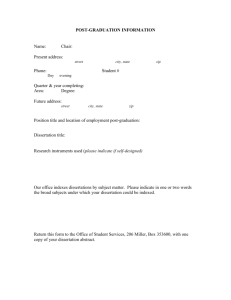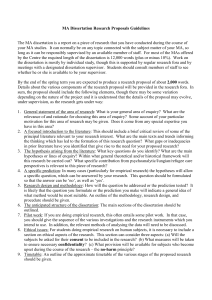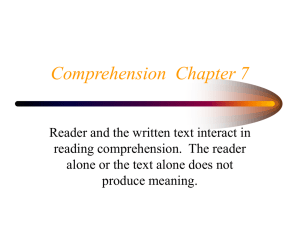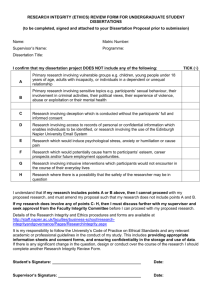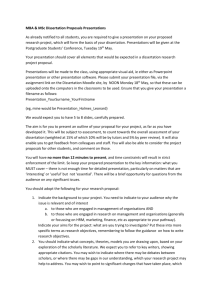Running Head: ANALYSIS OF THE THEORY ANALYSIS OF THE
advertisement
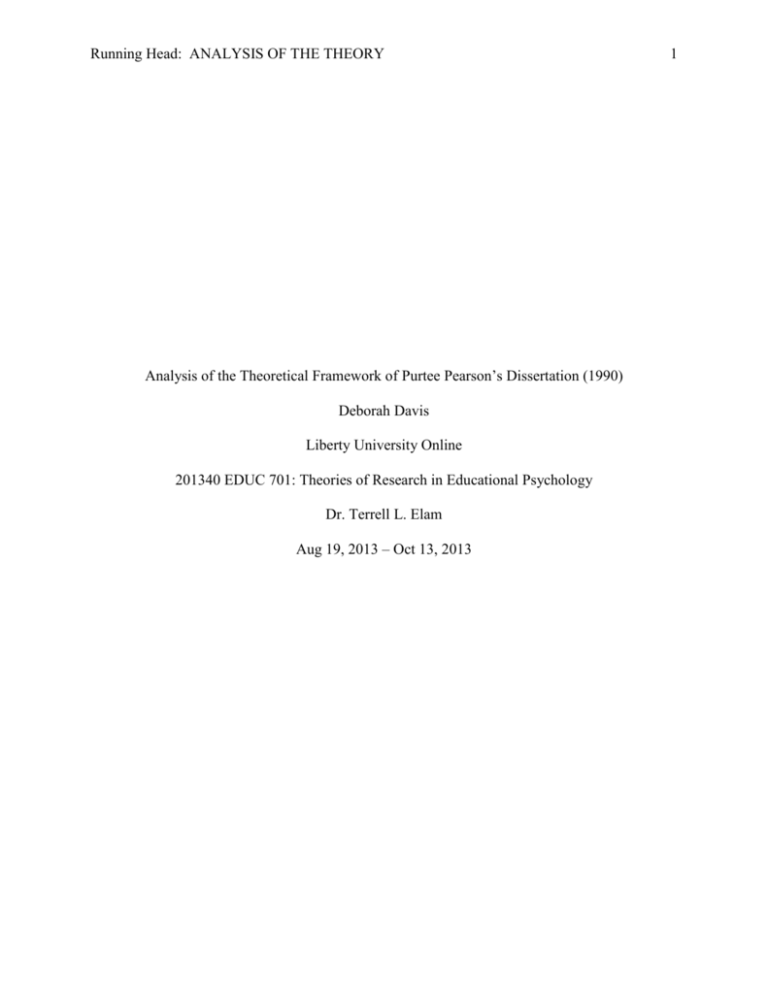
Running Head: ANALYSIS OF THE THEORY Analysis of the Theoretical Framework of Purtee Pearson’s Dissertation (1990) Deborah Davis Liberty University Online 201340 EDUC 701: Theories of Research in Educational Psychology Dr. Terrell L. Elam Aug 19, 2013 – Oct 13, 2013 1 ANALYSIS OF THE THEORY 2 Analysis of the Theoretical Framework of Purtee Pearson’s Dissertation (1990) A theoretical framework provides a stable structure of reference for a well-researched document. Further, that structure will provide a foundation on which the research questions may be laid and on which the logic of the research may be built. In Pearson’s (1990) Dissertation regarding the methods for increasing reading outcomes of fifth grade social studies students, she builds on such a framework. Summary A plethora of learning theories may clutter the mind of the educational student, but when dissertation time comes, that student must provide a clear and stable foundational theory (or two) on which to base a research question (or two or three). Purtee Pearson’s (1990) Dissertation is no different in this arena. Her foundation is the poured concrete of schema theory on the rock base of cognitive theories. Central Theory “Bartlett (1932) proposed the concept of ‘schema’ as an active organization [sic] of past reactions, or of past experiences, which are blended with current world information to produce behavior [sic]. A schema is a form of mental template” (as cited by Walker, 2012, p. 251). McVee, Dunsmore, and Gavalek “continue to talk about schema theory as a useful model of reading comprehension” (2005, p. 532). Thus, it is the logical choice for Purtee Pearson’s Dissertation regarding reading issues. Research Questions Purtee Pearson presented two research questions for this dissertation (1990): ANALYSIS OF THE THEORY 3 (1) Were the post-reading comprehension test scores following a lesson using anyone of the given prereading approaches significantly different at the .05 level from the lesson introduced by the control organizer? (2) Were the post-reading comprehension test scores following a lesson using anyone of the given prereading approaches significantly different at the .05 level from the other two? (p. 6). Considering the nature of the schemata as a foundational framework, particularly as regards reading comprehension, the questions are reasonable and logical and apply to the framework. In that “text has been determined to be only the framework for meaning” (Purtee Pearson, 1990, p. 16), the application of schemata to these questions provide a framework within a framework for the issue of comprehension. The whole process can be likened to the construction of a building. Cognitive theory is the rocky compacted soil. Schema theory provides the concrete foundation. The schemata themselves are the framing tools on which the text will be placed as would drywall in the solid places and glass in the windows of the building. So, too, will Purtee Pearson’s answers build on the framework of her questions. Much like the building, however, there are other frames to be put in place. These doorframes, window frames, and stairwells are the subordinate data collection questions that lead to the answers of the primary questions – these are the elements such as comprehension levels before and after each form of advance directive and the assumptions (basically the equivalency of all involved parties by tier – students, student teachers, supervising instructors) as well. Without these internal structures, despite a solid foundation, the building will fall; the research would fail. ANALYSIS OF THE THEORY 4 Conclusion The summary reflects that Purtee Pearson’s Dissertation (1990) provided a clear and relevant theoretical framework of schema theory. The research questions were easily understood and researchable, access to the research subjects was viable, and the schema theory provided a solid foundational structure for the answers. As such, the building plan has enough structure to hold firm and enough flexibility to make any modifications needed to withstand the realities of stormy weather – answer her research questions fully. ANALYSIS OF THE THEORY 5 References McVee, M.B., Dunsmore, K., & Gavelek, J.R. (2005). Schema Theory Revisited. Review of Educational Research, 75(4), 531-566. Retrieved from http://journals.ohiolink.edu.proxy01.shawnee.edu/ejc/pdf. Purtee Pearson, C. L. (1990). The comparison of the effects of three prereading advance organizers on the literal comprehension of fifth-grade social studies materials (Doctoral dissertation). Retrieved from http://digitalcommons.liberty.edu/cgi/ Walker, G. (2013). A cognitive approach to threshold concepts. Higher Education: The International Journal of Higher Education and Educational Planning, 65(2), 247-263. Retrieved from http://journals.ohiolink.edu.proxy01.shawnee.edu/ejc/pdf.cgi/Walker_Guy.pdf?issn=0018 1560&issue=v65i0002&article=247_acattc

